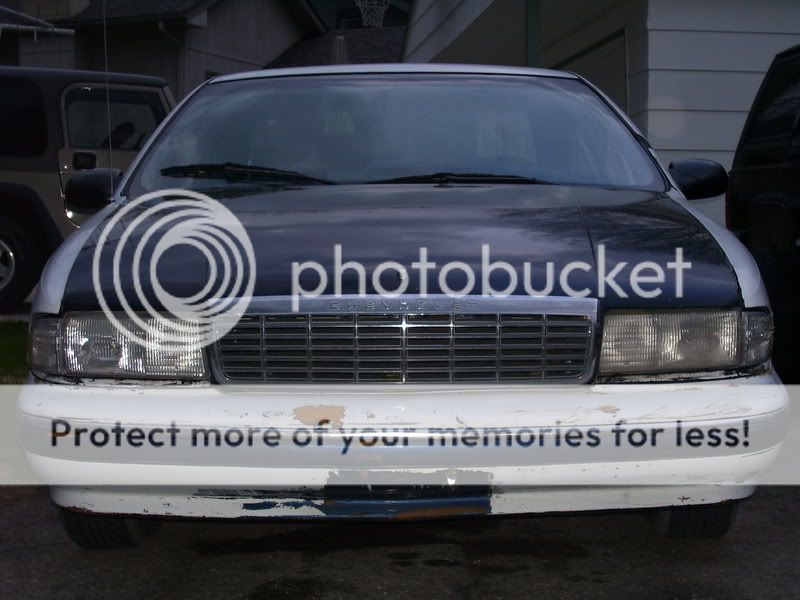BIGSLVRXJ
NAXJA Forum User
- Location
- Des Moines, Iowa
Hey all, I wanted to ask a few questions on here because I know several of you are fairly good at this stuff. I plan to paint 2 vehicles this summer... my 1990 XJ and my 1995 Chevy Caprice. Now to give a background on my painting skills...
I have completely rattle canned an MJ. It turned out decent but the one thing I was especially displeased with was the "tiger stripes" (I've heard that is the technical term for them) or the lines between passes of the spray. Here is a picture just for kicks...it exaggerates the tiger stripes quite a bit.

Anyway, since then I have bought a paint gun. It is a Finex model that was right around $150. I have gotten the basic idea of mixing the activator/reducer/paint pretty well. I have a DeWalt Emglo compressor that I plan to be painting with that can produce 4.5 CFM @ 100 PSI which I figure should be plenty powerful. I also have the regulator/drier to go along with it. My question about the compressor is, should I have it on the ground and the drier/regulator mounted above it to...for example...a stud?
Now on to the true painting questions...
The Jeep has been repainted by Maaco and most of it is holding on pretty well, but I want a color change. It was a cheap enamel paintjob so I will prep it down make sure it's no longer glossy and shoot it. Now my question is...very shortly I will be buying a soda blaster, should I blast it all the way down past the Maaco and Jeep paint and start over?
The Caprice has had a rattle can or very very gun paintjob done to it. It doesn't even appear they made an attempt to take the clear off the original paint, which really aggrevates me. Anyway, I took it to a car wash and could actually blast the 2nd cheap layer off. It was slow but I made some progress on the trunk lid. Should I rent/buy a pressure washer and blast the rest of it off, should I use aircraft stripper or should I just prep the 2nd crummy layer and paint over it? Here are a couple pictures that shows the worst of that 2nd paintjob...


I am going to get new plastic bumper skins for it also, the existing ones are not salvageable.
If anyone can help me out with some advice that would be swell. The only thing I don't want to hear is "you're not qualified to do it, take is somewhere". I want to go through this learning process so I can do it in the future. Any suggestions are greatly appreciated.
Thanks,
Collin
I have completely rattle canned an MJ. It turned out decent but the one thing I was especially displeased with was the "tiger stripes" (I've heard that is the technical term for them) or the lines between passes of the spray. Here is a picture just for kicks...it exaggerates the tiger stripes quite a bit.

Anyway, since then I have bought a paint gun. It is a Finex model that was right around $150. I have gotten the basic idea of mixing the activator/reducer/paint pretty well. I have a DeWalt Emglo compressor that I plan to be painting with that can produce 4.5 CFM @ 100 PSI which I figure should be plenty powerful. I also have the regulator/drier to go along with it. My question about the compressor is, should I have it on the ground and the drier/regulator mounted above it to...for example...a stud?
Now on to the true painting questions...
The Jeep has been repainted by Maaco and most of it is holding on pretty well, but I want a color change. It was a cheap enamel paintjob so I will prep it down make sure it's no longer glossy and shoot it. Now my question is...very shortly I will be buying a soda blaster, should I blast it all the way down past the Maaco and Jeep paint and start over?
The Caprice has had a rattle can or very very gun paintjob done to it. It doesn't even appear they made an attempt to take the clear off the original paint, which really aggrevates me. Anyway, I took it to a car wash and could actually blast the 2nd cheap layer off. It was slow but I made some progress on the trunk lid. Should I rent/buy a pressure washer and blast the rest of it off, should I use aircraft stripper or should I just prep the 2nd crummy layer and paint over it? Here are a couple pictures that shows the worst of that 2nd paintjob...


I am going to get new plastic bumper skins for it also, the existing ones are not salvageable.
If anyone can help me out with some advice that would be swell. The only thing I don't want to hear is "you're not qualified to do it, take is somewhere". I want to go through this learning process so I can do it in the future. Any suggestions are greatly appreciated.
Thanks,
Collin
Last edited:

